Thousands of Haitian migrants amassed at U.S.-Mexico border unsure what's next
After fleeing to Brazil following the 2010 earthquake, migrants like Lemoine Denera and his family are arriving at the border hoping to enter the U.S.
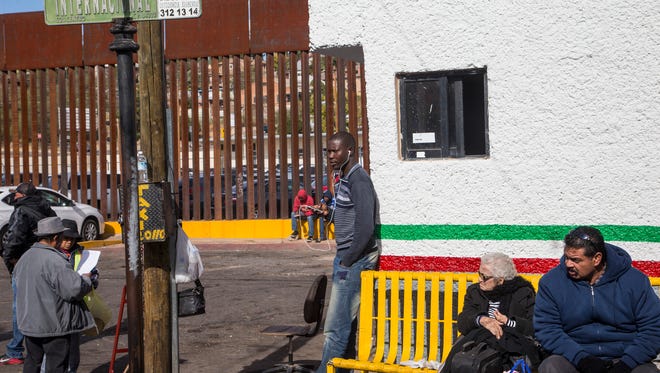
NOGALES, Sonora — For more than two years, Lemoine Denera had a steady job in Brazil, where thousands of Haitian men like him fled after the devastating 2010 earthquake.
Then Brazil's economy collapsed and Denera joined the thousands of Haitian migrants leaving Brazil and heading to the United States.
The journey to the U.S.-Mexico border took 2½ months.
After leaving on Sept. 17, Denera traveled more than 5,000 miles through 10 countries, passing through Peru, Ecuador and Colombia, Panama, Costa Rica, and Nicaragua, Honduras, El Salvador and Guatemala, and finally through Mexico to reach the U.S. border.
But after arriving, as he sat in a plastic chair in the late afternoon sun outside a makeshift shelter filled with French-speaking Haitian migrants in this border city, the 32-year-old man faced an agonizing decision for him and his family.
PHOTOS: Life for Haitian migrants at border
His grey hooded sweatshirt and his New York Yankees hat looked new, remnants of more prosperous times in Brazil.
But Denera could barely fill his clothes, his body emaciated from the journey.
When he left Brazil, the U.S. was granting humanitarian parole to groups of Haitian migrants arriving at the southern border even though they didn't have visas to enter the U.S. That allowed the Haitians to enter the U.S. through ports of entry, giving them hope that they might be allowed to remain in this country permanently.
But by the time Denera arrived in Nogales, Sonora, on Nov. 29, the situation had changed. The United States had resumed deporting Haitians back to Haiti.
So Denera was in a quandary.
Should he go ahead with his plans to cross into the U.S.? That would mean risking being quickly deported back to impoverished Haiti, which has since been further devastated by a hurricane.
Or should he stay put in Mexico, and try to get a work visa there?
The dozens of Haitian migrants arriving daily at border cities throughout Mexico now face the same dilemma. It's become the latest humanitarian crisis to hit the U.S.-Mexico border.
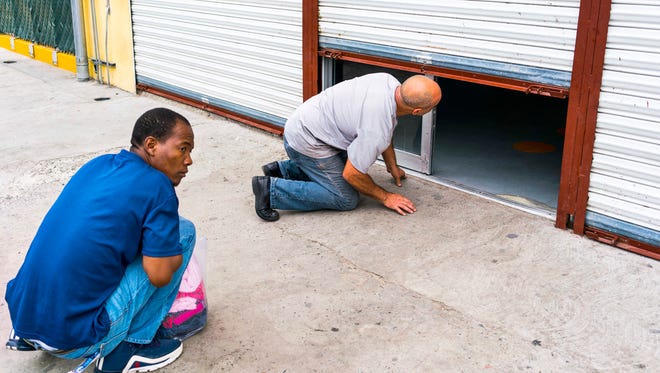
Some 7,000 Haitian migrants are currently stuck in border cities in Mexico hoping to cross into the U.S., according to David Cuauhtemoc Galindo, the municipal president of Nogales, Sonora, citing statistics he received from Mexican immigration authorities.
But Denera's plight is even more complicated. Unlike the majority of Haitian migrants, who are young men, Denera traveled to the border with his wife, 27-year-old Aline Sainaly Denera, and their 4-month-old daughter, Leina.
Would his family be allowed to remain together if placed in a U.S. immigration detention center, or would they be separated? Could he be deported without his wife and daughter? Denera pondered these questions as he debated whether to cross into the U.S. or remain in Mexico.
As he spoke, his daughter dozed off in his lap one recent chilly afternoon this month at the Rotary Club in Nogales. The club has been converted into a temporary shelter for Haitian migrants, who sleep on vinyl mats on the floor. They eat food brought to them daily by local groups.
Denera's daughter wore pink fleece pajamas. Her nose was running. Denera said the girl has had colds and a fever off and on throughout the journey.
He also has health problems of his own. He lifted up his shirt to show the spot where he had a hernia. He also pointed to a list of other medical problems, which he had translated from French to English using an app on his smartphone: stomach ulcers, heart valve insufficiency, hemorrhoids.
"I have to have medicine every day but for one month I don't have it," said Denera, speaking in Spanish and English.
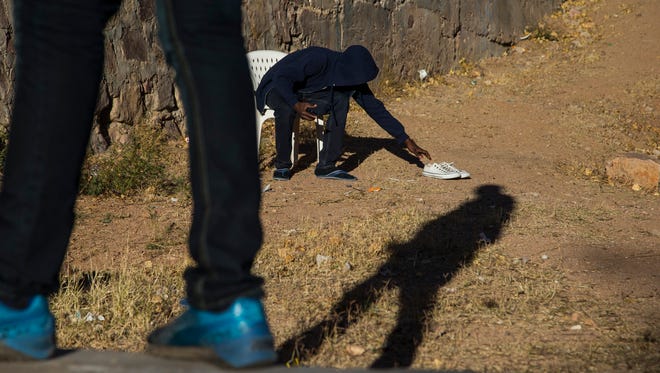
Between Sept. 20 and Nov. 16, U.S. Immigration and Customs Enforcement released 900 Haitians because of a lack of detention space, primarily the result of the surge in families and unaccompanied children from Central America also arriving at the border.
The Haitians who were released received papers ordering them to report to immigration court at a later date to determine their immigration cases. But about 4,400 Haitians were still being held in detention centers, Department of Homeland Security Secretary Jeh Johnson announced at the end of November.
One thing Denera knew for sure. He wasn't going back to Haiti. It's the poorest country in the Western Hemisphere. Ninety percent of workers in Haiti make their living doing odd jobs, earning $2 a day, said Eduardo Gamarra, a Haiti expert at Florida International University.
The country also is still recovering from the devastating 2010 earthquake. The quake killed 160,000 people in the country's capital, Port-au-Prince, displaced 1.5 million people, and caused $7.8 billion in damage.
On top of that, the country was hit hard in October by another major natural disaster, Hurricane Matthew. The Category 5 hurricane has killed more than 1,000 people, according to some news reports, and displaced hundreds of thousands.
"Returning to Haiti would be the worst for me," Denera said.
During his 2½ month journey from Brazil to Nogales, Denera said he and his wife took turns holding their baby. The girl was less than 2 months old when they started their trip to the U.S. border.
Sometimes the three of them traveled by bus. Other times they walked for days.
"We slept on the streets," Denera said.
While trekking up a mountain in Panama, another Haitian migrant walking in front of them slipped and grabbed a tree branch to catch his balance. But the branch snapped and swung backwards, hitting the baby in the head.
"She cried and cried and cried," Denera recalled. But he couldn't get her to a doctor to see if she was OK.
Brazil opened its doors to Haitians after the 2010 earthquake when Brazil's economy was booming, said Gamarra, who travels frequently to Haiti.
He estimates 50,000 Haitians moved to Brazil after the quake. They mostly worked in construction and agriculture jobs, he said.
But Brazil's economy is now in a deep recession, triggered by a political crisis, he said. Millions of Brazilians are out of work.
Now the Haitians are no longer welcome. That is prompting many Haitians to leave Brazil and head for the United States, where many already have relatives, Gamarra said.
"When there is an economic slowdown, the usual culprit is the foreigners," Gamarra said. "They are accused of taking jobs away from hard-working Brazilians."
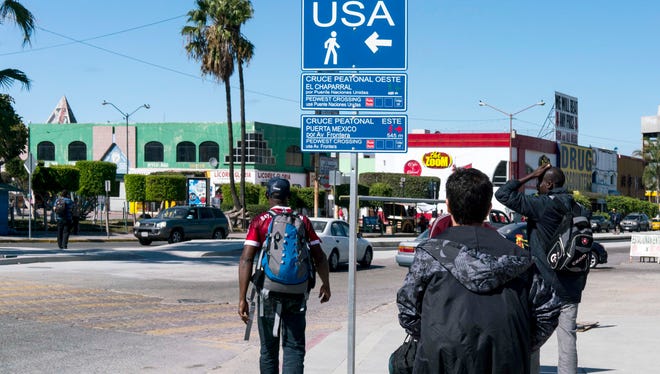
Denera worked at an egg production plant in Brazil feeding chickens.
Now, "my dream is to go to the United States," he said.
The first wave of Haitian migrants began arriving at the border in Tijuana back in May, said the Rev. Patrick Murphy, a Catholic priest who runs the Casa del Migrante, a shelter for deported migrants in Tijuana.
Many of the Haitian migrants claim to be from Congo, the troubled nation in central Africa, to avoid being deported, he said.
At the same time, the city also experienced a spike in migrants from Central America and Africa seeking asylum in the U.S., overwhelming local migrant shelters, Murphy said. Most received humanitarian visas by Mexican immigration authorities after crossing into Mexico from Guatemala, allowing them to travel legally through Mexico.
RELATED: Border crisis: Immigrant children
The flow has since slowed down in Tijuana. But it has spread to other border cities in Mexico.
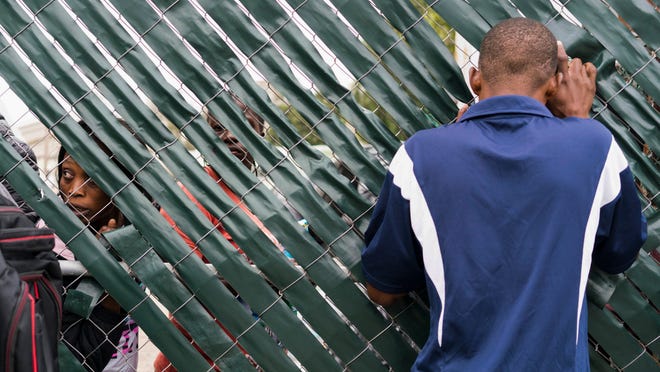
Haitians from Brazil are now traveling to Mexicali, across from Calexico; San Luis Rio Colorado, across from Yuma; Agua Prieta, across from Douglas; and Juarez, across from El Paso, according to interviews with Haitians in Nogales, Sonora.
Communicating with each other by cellphone, the Haitians said they try to head to border cities where there are fewer numbers of Haitians. That way they have a better chance of not having to wait too long to be interviewed by U.S. Customs and Border Protection officials.
In Nogales, Haitians began arriving on Oct. 19, said Galindo, the municipal president.
"They arrived in small groups, mostly men," Galindo said.
At first, the Haitians were sleeping on the floor inside the port of entry on the Mexican side, blocking the pedestrian lane to enter the U.S.
The situation prompted Mexican government officials to hold an emergency meeting on Oct. 25. They created a plan to handle the influx of Haitian migrants and provide them with a place to sleep, blankets, food, and drinking water, Galindo said.
He estimated between 200 and 250 Haitians have arrived in Nogales since October. But the numbers arriving have tapered off. On that particular day in early December, there were a total of 60 Haitians being housed at shelters in Nogales, 14 at the San Juan Bosco shelter and 44 more at the Rotary Club.
Migrants have been passing through Nogales on the way to the United States for decades. But most of them come from the interior of Mexico and increasingly from Central America, said Franciso Loureiro, who has run the San Juan Bosco shelter since the early 1980s.
This is the first time he has seen migrants from Haiti, Loureiro said.
Taped to the wall of the dining room inside the shelter was a list of 132 names of Haitians who had passed through the shelter since October.
The few Haitians remaining that night had decided not to cross, Loureiro said.
"They are afraid they will be deported back to Haiti," Loureiro said.
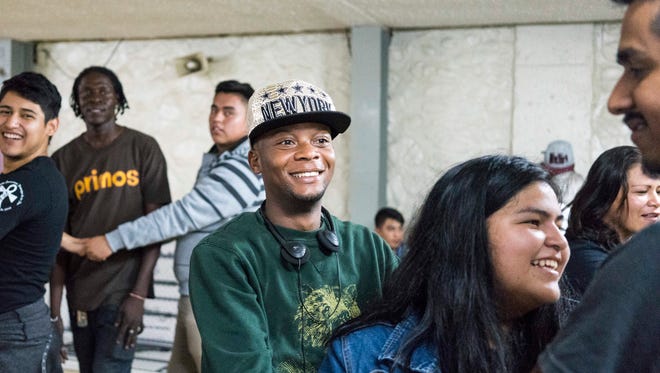
One recent night, about a dozen Haitians could be seen huddled together sleeping on the floor under colored blankets inside an empty office of the National Institute of Migration, Mexico's immigration department.
The next morning, they stood inside the office eating plates of scrambled eggs and sausage. The food was delivered by the Red Cross and volunteers from the Parroquia El Señor de la Misericordia, a Catholic church. The church is one of 10 local groups taking turns providing meals to Haitian migrants stuck at the border, said Miguel Guzman, a church member.
Several of the Haitian migrants waiting inside the office held yellow folders in their hands.
Gerson Maxime, a 27-year-old Haitian, opened his folder. He pulled out copies of his Haitian passport and an application for a Mexican work visa.
He has given up trying to enter the U.S. and decided instead to stay in Mexico, "because the U.S. is deporting the Haitians."
The U.S. suspended deportations to Haiti following the 2010 earthquake. Officials were concerned that sending the immigrants back would put their lives at risk and could further destabilize the country.
The suspensions opened the door for Haitians arriving at the border to be allowed into the U.S. through humanitarian parole. That led some to be released pending the outcome of deportation cases. That triggered more to come after word spread back to Brazil, said Faye Hipsman, a policy analyst and Haiti expert at the Migration Policy Institute, a nonpartisan non-profit research center in Washington, D.C.
On Sept. 22, however, President Barack Obama's administration resumed deportations to Haiti. The shift was prompted in response to the spike in Haitian migrants who previously had found work in Brazil streaming to the U.S. border through Mexico, Hipsman said.
The U.S. briefly suspended deportations to Haiti again following Hurricane Matthew, but the deportations resumed in November.
As a result of the new deportation policy, Haitians who enter the U.S. without visas are now being subjected to fast-track deportations, known as "expedited removal" since the majority likely do not qualify for asylum, or other legal avenues to stay, Hipsman said.
The decision to resume deportations to Haiti has angered some human-rights advocates.
"I'm very upset about that policy because I think the U.S. government is sending them back to an untenable situation for them," said Rev. Sean Carroll. He runs the Kino Border Initiative, a binational Catholic group that has a shelter for deported migrants in Nogales, Sonora, where some Haitian migrants have been staying.
He would like to see the U.S. allow Haitians arriving at the border to live and work temporarily in the U.S. until conditions improve in Haiti.
"It's a country that has been devastated by both the earthquake in 2010 and Hurricane Matthew this past year and I would say that almost to a person the people who are being deported there are going to have a very difficult time, if not impossible, to set up a life there in Haiti," he said.
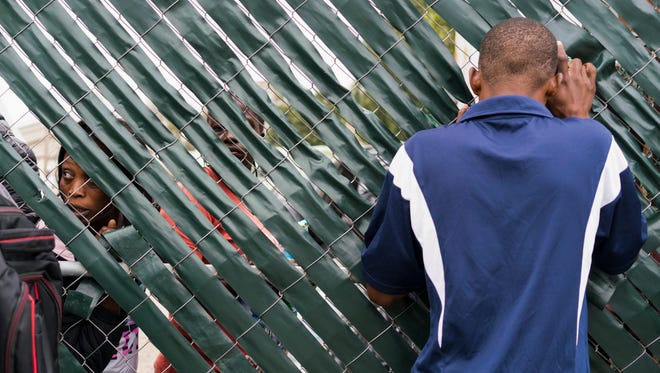
Denera, the Haitian who traveled to Mexico with his family, stood next to the border fence one morning earlier this month, contemplating what to do next.
Through the slats, he could peer into the streets of Nogales, Arizona, as pedestrians who had just entered Mexico from the United States through the port of entry streamed by after passing through a metal turnstile.
At the port, Denera was hoping to schedule an interview with U.S. immigration officials so he could explain his situation. He planned to tell them about his wife, and their baby, who had grown sicker, and also about his own health problems.
Over the next several days, Denera texted a reporter updates on WhatsApp, the free international messaging phone app.
In one, Denera said he had met with a migrant advocate from the Kino Border Initiative.
"I met Marla, she told me it's hard, but she'll get in touch with the authorities to see what can be done," he wrote.
The next day, Denera responded again.
"Ola my Frend! The migration comes to get us to cross, I do not know what to do? How can you help me please? I am very afraid of not losing my family," he wrote.
Then, suddenly, Denera stopped responding to texts.
A friend, also reached through WhatsApp, said Denera had made a decision.
He and his family had entered the U.S. the night before.
Postscript: Aline Sainaly Denera contacted The Republic on Monday and said that she and her 4-month-old daughter, Leina, had been released from federal custody and were on their way to New York, where they have family. Lemoine remains held in a federal detention center.